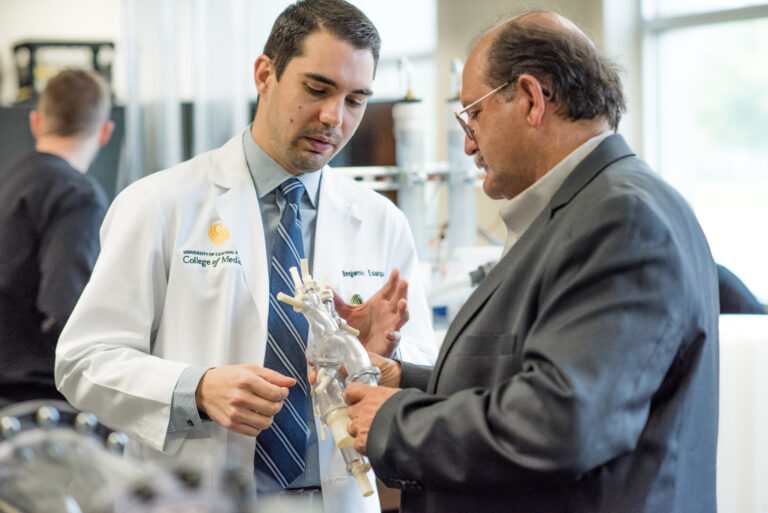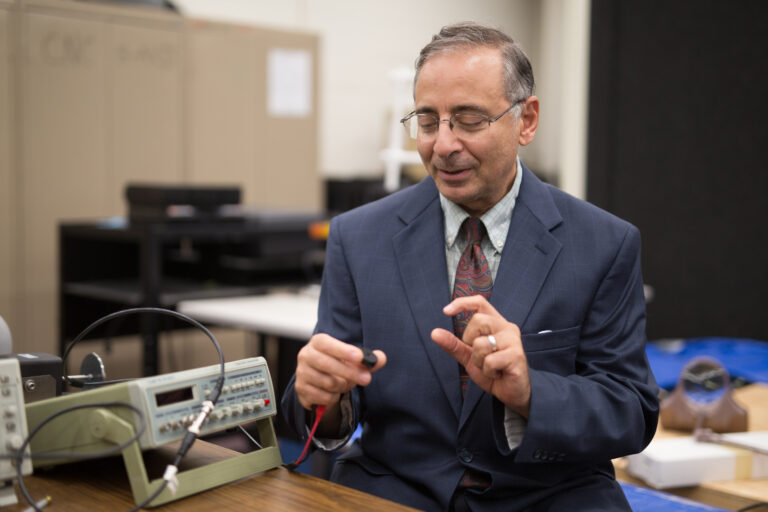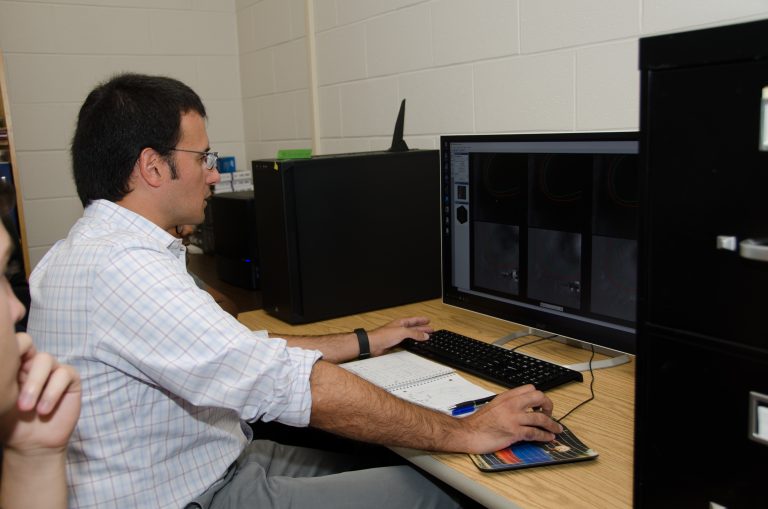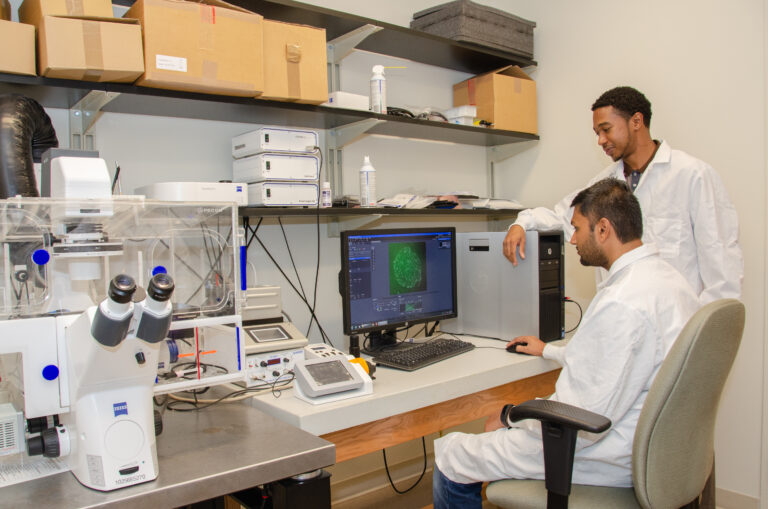UCF’s engineers do more than develop innovative space technology or reimagine the next generation of wind turbines — they also solve matters of the heart.
Several mechanical and aerospace engineers at UCF focus their expertise on finding creative solutions to various heart conditions. Heart disease is the leading cause of death for men and women in the United States with one person dying every 36 seconds, according to the Centers for Disease Control.
“It’s rewarding to work on such interesting problems at the interface of engineering and medicine with the precise aim to improve quality of life,” says Alain Kassab, a professor and director of the UCF biomedical engineering program.

Removing the Defects From Pediatric Open-Heart Surgery
When children are born with a defective ventricle, they typically undergo a series of three surgeries to reconfigure the heart and the circulatory system. During the final procedure, a new system known as Fontan circulation is established. This allows the blood that returns from the body to flow directly to the lungs without passing through the heart, while the single functioning ventricle pumps blood to the body.
Children typically undergo the Fontan procedure between the ages of 1 and 3. While it may help them survive infancy, it doesn’t guarantee that they’ll live a long life.
“A substantial proportion of patients with the Fontan circulation do not do well as a consequence of having taken the pumping right ventricle out of the pulmonary or ‘Fontan’ side of the circulation,” says Kassab. “Although this surgical treatment began nearly 30 years ago, the mortality rate is still elevated with nearly half of patients not surviving beyond the age of 20.”
“Physicians believe that a substantial proportion of patients with the Fontan circulation do not do well because the pumping right ventricle has been taken out of the pulmonary side of the circulation,” says Kassab. “Although the first Fontan surgery was performed nearly 50 years ago, the mortality rate is still elevated with nearly half of patients not surviving beyond the age of 20.”
To improve upon the defects created by Fontan circulation, Kassab is collaborating with a team of multidisciplinary researchers to develop a self-powered injection jet shunt that utilizes the heart’s own energy to alleviate the increase in pressure caused by the rerouted circulatory system.
The team — which includes William DeCampli, the chief of pediatric cardiac surgery at Arnold Palmer Children’s Hospital and a professor of surgery at the UCF College of Medicine; Ray Prather ’13 ’15MS ’18PhD, a senior research associate at Arnold Palmer Children’s Hospital; and Eduardo Divo ‘98PhD, the chair of the Department of Mechanical Engineering at Embry-Riddle Aeronautical Engineering — initiated this project in 2015. Together, they’ve secured more than $700,000 in grants from the American Heart Association, the Children’s Heart Foundation, and Additional Ventures, a nonprofit that supports research on single ventricle heart defects.
“Our close collaboration with Dr. DeCampli and Arnold Palmer Children’s Hospital is the key to effectively addressing such a complex multi-disciplinary problem,” says Kassab. “Each team member brings key expertise to bear on the critical aspects of the physics and physiology of the problem.”
The latest research data was published in Scientific Reports on Feb. 9.

Monitoring Heart Failure Through Sound
Patients who have been diagnosed with heart failure may be able to monitor their heart health with the aid of a credit card-sized device in the near future. This innovative, non-invasive heart monitor will use acoustic technology to monitor the deterioration of heart function, which could reduce the need for patient hospitalization and even prevent death.
Associate Professor Hansen Mansy, who runs the Biomedical Acoustics Research Laboratory, is developing this device in collaboration with Richard Sandler of the UCF College of Medicine. The pair received a $1.3 million grant from the National Institutes of Health in 2017 to complete the project.
The device is designed to be used by patients, but it will provide important data to physicians who can determine if further medical intervention is necessary. Patients will place the small device over their chests and a sensor will detect the chest vibrations caused by their heart activity. That recorded activity can then be uploaded to a mobile phone or computer and sent to physicians daily via a secure patient portal.
Physicians can use the data to determine if a patient’s heart heath is worsening. If it is, they can implement a more effective treatment plan that can prevent hospitalization and improve the patient’s quality of life.
Mansy and his research team have already begun clinical testing on the device.
“Although the clinical testing has been slowed down due to COVID-19, initial results are encouraging and suggest that early detection of the need for hospital readmission may be feasible using our proposed methods,” Mansy says.
The team has used advanced signal processing methods to measure the electromechanical signals of the heart. The features of those signals are extracted and the data is put into a machine learning algorithm that builds the model that can predict heart function deterioration.
Mansy and Sandler are collaborating with AdventHealth and the Biomedical Acoustics Research Company on the project. Mansy says that the next steps for the team include further analysis and additional clinical testing.

Creating Faster and More Accurate Diagnoses
In the Computational Biomechanics Lab, Assistant Professor Luigi Perotti and his team are using computational modeling to develop a new non-invasive method of detecting the biomarkers of cardiac deformation, which could lead to faster and more accurate diagnoses of heart disease.
“One of our main focuses is to analyze imaging data to determine the biomarkers of cardiac health,” Perotti says. “These biomarkers could then be extracted from patient-specific data and indicate the onset or progression of cardiac diseases.”
By using patient data that is already available in the clinic rather than data acquired through a research setting, Perotti says that physicians can diagnose their patients much faster. He believes their diagnoses can also be more accurate by using aggregate cardiomyocyte strains — made of the cells responsible for contracting the heart and pumping blood through the circulatory system — as biomarkers for cardiac health.
Perotti is collaborating on this project with researchers from Stanford University and the University of Lyon.

How Biomechanical Forces Influence Heart Disease
While his colleagues look for solutions to the problems caused by heart disease, Assistant Professor Robert Steward uses his engineering expertise to explore the problems that cause heart disease.
With the support of a $738,000 grant from the National Institutes of Health, Steward has spent the past five years investigating the biomechanical forces that can influence the early stages of heart disease known as atherosclerosis. This stage is characterized by an excessive buildup of white blood cells and bad cholesterol in the arteries. Steward found that blood flow induces mechanical stress that allows white blood cells to enter weak areas of the heart.
“The findings yielded from this work have the potential to lead to novel, mechanics-based therapeutics for cardiovascular disease,” Steward says.
Steward collaborated with Sampath Parthasarathy from the UCF College of Medicine on the project, which officially concludes in May. He plans to publish the findings in an academic journal in the coming months.
In the meantime, Steward will use his CAREER grant, sponsored by the U.S. National Science Foundation, to pick up where the NIH project left off. He was one of five UCF researchers to receive the award this past year.
He says the NSF project will focus on the basic science of how biomechanical forces influence the endothelium, a group of cells that line the blood vessels in the body, including the arteries. With this knowledge, better therapies for heart disease could be developed, or the disease could potentially be eliminated.
Over the past few months, Steward and his Cellular Biomechanics Lab have been exploring the use of machine learning algorithms to predict the biomechanical response of the endothelium, but he says further refinement is needed for this portion of the project.
About the Researchers
Kassab joined UCF in 1991 and has received numerous awards and distinctions since then, including the titles of Pegasus Professor and UCF Trustee Chair. His research spans several disciplines in computational heat transfer and fluid dynamics, inverse problems, boundary element and meshless methods. He has been funded by the American Heart Association, Orlando Health, Siemens, the U.S. National Science Foundation,and NASA, to name a few. He earned his bachelor’s degree in engineering sciences and his master’s and doctoral degrees in mechanical engineering, all from the University of Florida. He is also a fellow of the American Society of Mechanical Engineers and the American Institute for Medical and Biological Engineering.
Mansy received his Ph.D. at the Illinois Institute of Technology and bachelor and master’s degrees at Cairo University in Cairo, Egypt. He was associate professor of bioengineering at Rush Medical College before joining UCF. He has been developing vibro-acoustic medical technologies for the past 20 years with continuous support from the National Institutes of Health. He has supervised bioengineering student projects at Rush Medical College, University of Illinois at Chicago and UCF and has developed bioinstrumentation, and mechanical and aerospace engineering measurements lab facilities at UCF and Illinois Institute of Technology.
Perotti received his undergraduate degree in civil engineering from Politecnico di Milano in Italy and his master’s and doctoral degrees from the California Institute of Technology. He served as an America Heart Association postdoctoral fellow at UCLA and in 2017, he received an NIH K25 Mentored Quantitative Research Career Development Award to continue his research on combining computational models with MRI data and conduct pre-clinical studies. He joined UCF as an assistant professor in 2019.
Steward joined UCF as an assistant professor in 2015. He previously served as a postdoctoral scholar at the Harvard T.H. Chan School of Public Health, where he investigated the influence of fluid shear stress on endothelial biomechanics. He earned his doctoral degree at Carnegie Mellon University and his bachelor’s degree at Clark Atlanta University. Steward currently runs the Cellular Biomechanics lab located on UCF’s Health Science Campus at Lake Nona, where he has multiple projects with the ultimate goal of linking mechanics and medicine.
